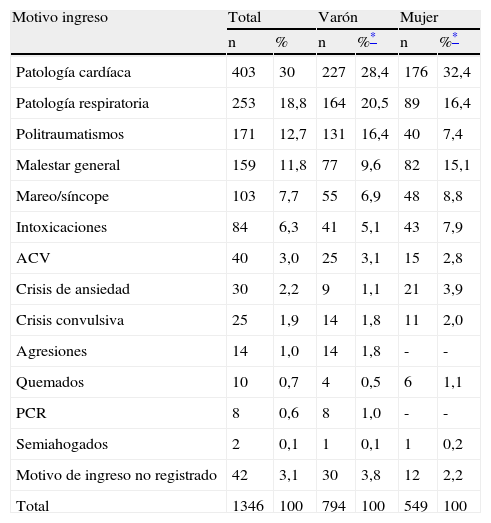Identificar las causas de ingreso más comunes en la sala de reanimación (SR) del servicio de urgencias y analizar las variables que modifican su frecuencia.
MétodoSe realizó un estudio observacional descriptivo retrospectivo durante los meses de julio y agosto del año 2004, y durante enero y febrero del año 2005, analizando una muestra de 1.346 pacientes, que se obtuvieron del libro de registro de la SR de urgencias; los datos referidos a edad y sexo se obtuvieron de la base informática interna del centro hospitalario. Las variables utilizadas en este estudio fueron edad, sexo, turno, fecha y destino del paciente.
ResultadosLos motivos de ingreso más frecuentes fueron la patología cardíaca, la patología respiratoria y los pacientes con politraumatismo. Aunque se obtuvo una mayor afluencia de varones (59,5%), los porcentajes entre las causas de ingreso variaron según el sexo del paciente. Se observó una mayor frecuencia de pacientes en el turno de la mañana (37,8%), los lunes (17,7%), y durante el mes de enero (30,5%), con algunas variaciones según las patologías y el sexo. Se derivó a los pacientes, en su mayoría, al área de observación de urgencias.
ConclusiónLos motivos de ingreso y la frecuencia se vieron modificados según las variables estudiadas.
To identify the most common causes of admission to the resuscitation room of the emergency service and to determine which variables modify this frequency.
MethodsAn observational retrospective study was performed during the months of July-August, 2004 and January–February, 2005. A sample of 1346 patients obtained from the registration book of the resuscitation room was analyzed. Information on age and sex was obtained from the hospital's internal database. The variables analyzed were age, sex, shift, date, and patient destination.
ResultsThe most frequent causes of admission were heart disease, respiratory disease and polytrauma. Although there was a higher percentage of males (59.5%), the percentages among the causes of admission changed according to the sex of the patient. There was a higher number of patients during the morning period (37.8%), on Mondays (17.7%), and in January (30.5%), with some variations according to cause and sex. The most common patient destination was the observation area of the emergency service.
ConclusionThe causes and frequency of admission were influenced by the variables studied.
Artículo
Comprando el artículo el PDF del mismo podrá ser descargado
Precio 19,34 €
Comprar ahora







